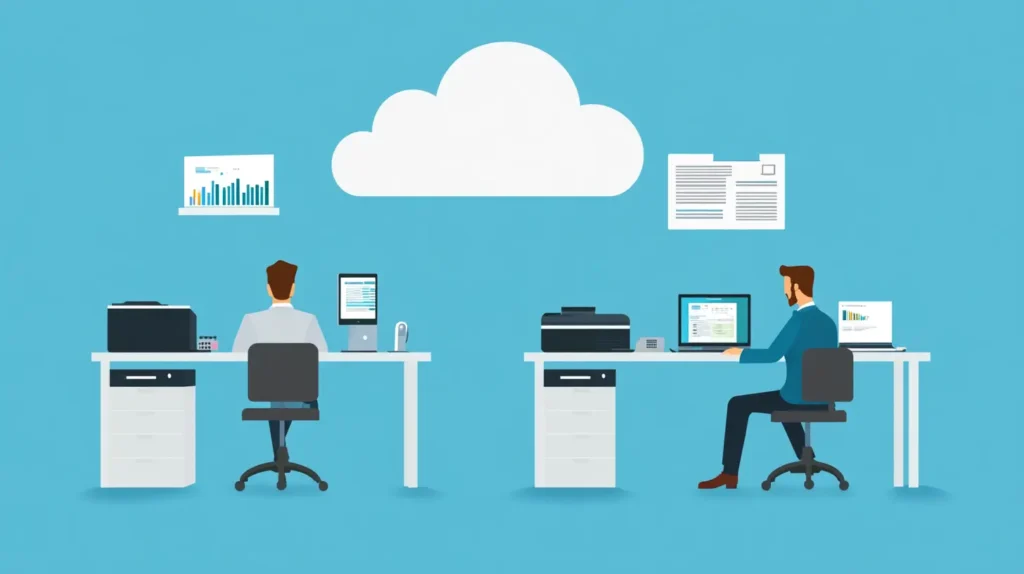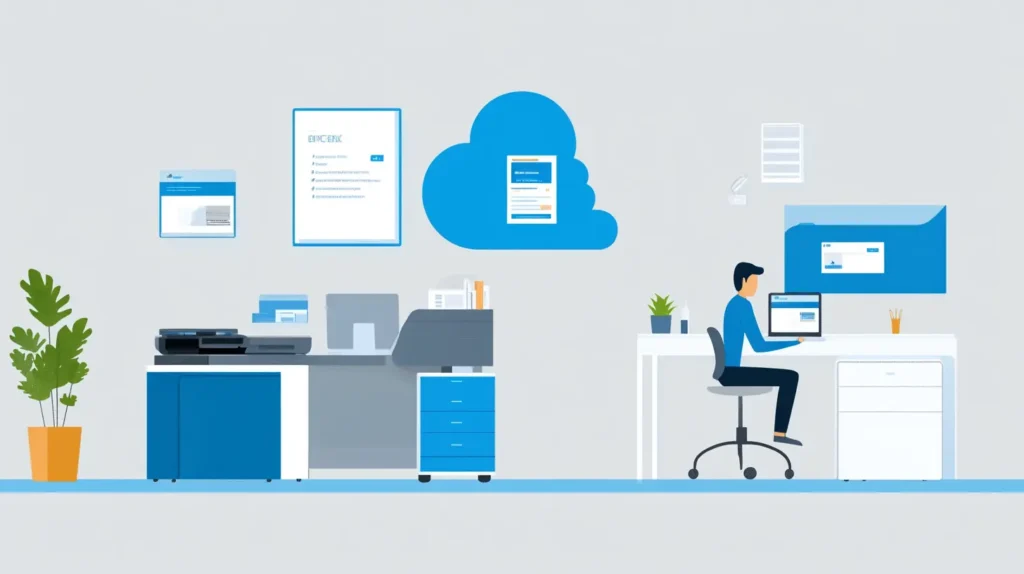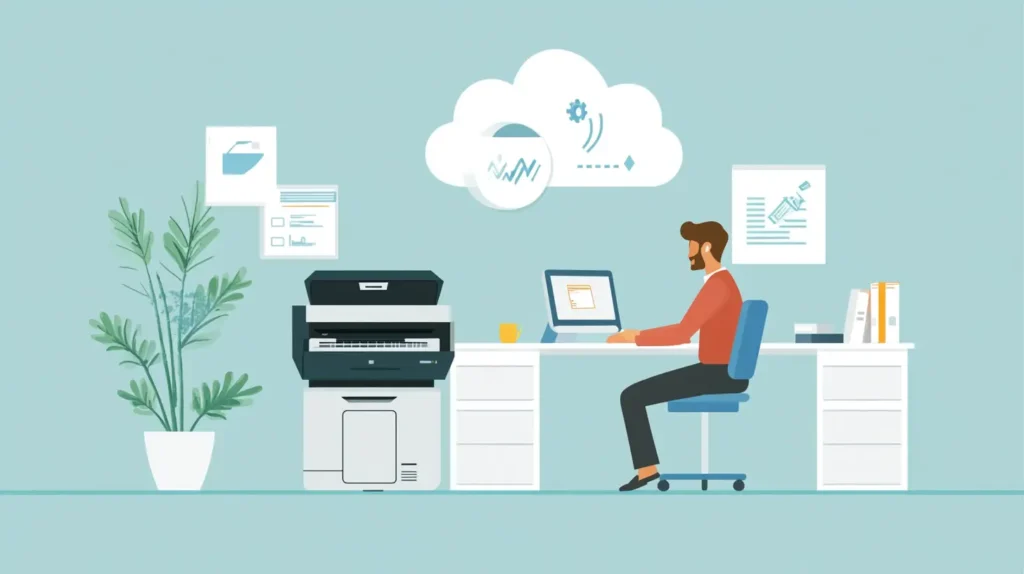In today's rapidly evolving workplace landscape, cloud printing has emerged as a transformative technology reshaping how businesses operate in the digital age. From bustling corporate headquarters to quiet home offices, this innovative solution is revolutionizing document management while supporting the global shift toward flexible work environments, particularly across Europe and the United States.
Cloud printing allows businesses to manage and print documents remotely, improving efficiency and reducing the need for traditional office equipment. With access to printers from anywhere, employees can print documents directly from their devices, whether they are in the office, at home, or on the go. This solution also enhances security and reduces costs, making it an essential tool for modern businesses navigating the remote work revolution.
The following article explores how cloud printing technology is transforming workplace operations, supporting sustainability initiatives, enhancing security, and contributing to cost efficiency. We'll examine current adoption trends in Europe and the U.S., and provide insights into how organizations can leverage this technology to stay competitive in an increasingly digital business landscape.

As remote work has risen in popularity, organizations have had to adapt to new ways of maintaining productivity and collaboration. Cloud printing has emerged as a key solution in this transformation. It enables seamless access to printing capabilities, even from remote locations, making it a vital tool for hybrid work models. In this section, we will explore how cloud printing is reshaping the way businesses approach printing in a hybrid environment.
Cloud printing is revolutionizing the way remote and hybrid workers access and use printing services, providing seamless and efficient printing solutions regardless of their location.
Remote work has significantly changed the way businesses operate. With the rise of cloud technologies, employees no longer need to be physically present in an office to access essential resources, including printers. Remote work offers flexibility, but it also brings challenges, especially when it comes to printing documents securely and efficiently. Cloud printing addresses these challenges by allowing workers to print from virtually anywhere, ensuring that they can stay productive, even when working remotely.
Organizations that have embraced hybrid work models have discovered that traditional office printing methods are often impractical for distributed teams. Cloud printing streamlines this process, allowing employees to print documents from home or the office effortlessly. This flexibility not only improves productivity but also ensures the maintenance of high security standards for sensitive documents.
| Key Benefits of Cloud Printing | Impact on Hybrid Work |
|---|---|
| Remote Accessibility | Employees can print from anywhere, eliminating the need for on-site office printers. |
| Cost Efficiency | Reduces the cost of maintaining multiple printers at various office locations. |
| Enhanced Security | Sensitive documents are protected with secure authentication before printing. |
| Environmental Impact | Cloud printing reduces the need for physical infrastructure and paper waste. |
Cloud printing is not just about remote access to printers; it also offers a range of features that make it an indispensable part of hybrid work models. These include:
The transition to hybrid work environments has highlighted the importance of digital solutions like cloud printing. Traditional on-site printing methods simply cannot support the flexibility and security needed in a distributed workforce. Cloud printing bridges this gap, ensuring employees can print securely and efficiently, regardless of their location.
The traditional office model relied heavily on a centralized printing infrastructure. However, in a hybrid work model, employees are working from various locations—home, office, or other remote spots. This requires an updated approach to ensure that printing needs are met without compromising security, accessibility, or efficiency. Cloud printing answers this need by offering flexibility and accessibility, enabling workers to print as needed without the constraints of physical office locations.
One of the most significant challenges in hybrid work environments is ensuring that both remote and in-office employees have equal access to printing resources. Cloud printing solutions solve this problem by integrating seamlessly with existing workflows and allowing for real-time access to printers. The key to successful implementation lies in selecting a reliable cloud printing solution that supports various devices, provides secure print jobs, and integrates effectively with enterprise software systems.

As businesses increasingly adopt cloud-based solutions, cloud printing has become an essential tool for improving operational efficiency and securing sensitive information. For organizations with a hybrid or fully remote workforce, cloud printing offers not just convenience but also significant cost savings and enhanced security measures. In this section, we'll explore how cloud printing drives both cost efficiency and security, helping businesses streamline their operations while protecting critical data.
Cloud printing helps businesses reduce costs, enhance security, and simplify print management by integrating printing processes into the cloud, offering accessible and secure print solutions.
The traditional method of printing often involves maintaining several on-site printers and managing their maintenance, supplies, and repair costs. These expenses can add up quickly, especially for businesses with multiple offices or a distributed workforce. Cloud printing significantly reduces these costs by streamlining the printing process and eliminating the need for multiple physical printers.
Organizations that have transitioned to cloud printing solutions typically observe an immediate reduction in printing hardware costs. Instead of investing in expensive on-site printers for every department or location, businesses can rely on a centralized cloud-based solution. According to recent industry reports, companies implementing cloud printing solutions have reported cost savings of up to 30% in hardware and maintenance expenses.
| Cost Benefit of Cloud Printing | Impact on Businesses |
|---|---|
| Reduced Hardware Costs | Eliminates the need for multiple printers in different locations. |
| Lower Maintenance Costs | Reduces the need for regular printer maintenance and repairs. |
| Reduced Paper Waste | Efficient print management tools minimize unnecessary printing. |
| Energy Savings | Fewer physical printers result in lower energy consumption. |
Security is one of the top concerns when it comes to cloud-based solutions, and cloud printing is no exception. However, cloud printing offers several advanced security features that protect sensitive documents and control access to printing resources.
Modern cloud printing solutions incorporate strong encryption, secure user authentication, and comprehensive job tracking features to safeguard company data. Documents are only printed once the user is authenticated at the printer, ensuring that confidential information is protected. Additionally, print jobs are encrypted in transit, preventing any unauthorized access or data breaches.
The ability to control who can access printing services is another advantage of cloud printing. With centralized management, administrators can set permissions and monitor print activity, ensuring that sensitive materials are only printed when authorized. Research indicates that approximately 70% of businesses cite improved document security as a primary benefit of cloud printing adoption.
| Security Feature | Impact on Businesses |
|---|---|
| User Authentication | Ensures that only authorized users can access print services. |
| Data Encryption | Protects documents while they are being sent to the printer. |
| Print Job Tracking | Monitors and logs all print activities for added accountability. |
| Access Control | Provides granular control over who can print certain documents. |
Adopting cloud printing helps businesses minimize risks associated with data breaches and unauthorized access to confidential information. The flexibility of cloud printing also allows businesses to scale their operations while keeping printing costs under control. From an operational perspective, moving to the cloud frees up valuable resources that were previously spent managing on-site printers and their upkeep.
Cloud printing systems enable organizations to allocate more resources to higher-value tasks, such as employee training and innovation. Additionally, these systems reduce risks related to printer malfunctions, as the cloud system automatically alerts administrators if there are any issues with print jobs or printer status, allowing for proactive management and minimizing downtime.

Cloud printing has been rapidly gaining traction worldwide, especially in Europe and the United States, as businesses look to streamline their printing processes while supporting remote and hybrid work environments. Understanding the trends and statistics around cloud printing adoption in these regions can provide valuable insights for businesses considering making the switch to cloud-based printing solutions. In this section, we'll explore the key market trends and statistics regarding cloud printing adoption in Europe and the U.S.
Cloud printing adoption is increasing in Europe and the U.S. as businesses prioritize flexibility, cost efficiency, and security in their printing infrastructure.
In Europe, cloud printing adoption has seen a significant uptick, driven by the increasing demand for flexible, remote-friendly solutions. As companies embrace hybrid work models and move towards digital transformation, the need for secure and accessible cloud printing solutions has become essential.
According to recent market research, organizations across Europe are increasingly investing in cloud printing technologies. Industry analysts predict that the European cloud printing market will continue to experience robust growth in the coming years. Key factors contributing to this growth include the rise of remote working, the push for sustainability, and the need for secure document management solutions.
| Key Statistics on Cloud Printing Adoption in Europe | Impact on Businesses |
|---|---|
| Cloud Printing Adoption Rate | Over 50% of European businesses are adopting cloud printing solutions, according to recent surveys. |
| Growth Rate | The European market for cloud printing is expected to grow by 20% annually through 2025. |
| Remote Work Influence | 70% of companies in Europe report an increase in cloud printing use due to hybrid work models. |
| Sustainability Focus | 65% of businesses are adopting cloud printing for its eco-friendly benefits, reducing paper waste. |
In the U.S., cloud printing adoption has also grown rapidly as businesses recognize the benefits of moving away from traditional, on-site printing infrastructure. Much like in Europe, the increasing prevalence of remote and hybrid work environments has spurred the demand for cloud-based printing solutions.
U.S. businesses are seeking ways to reduce operational costs while ensuring their employees can print securely from any location. According to industry reports, a significant percentage of businesses in the U.S. have already transitioned to cloud printing, with adoption rates continuing to climb.
Several factors are driving the rapid adoption of cloud printing in both Europe and the U.S. These include:
These driving factors are evident as businesses across both regions increasingly prioritize cloud solutions. The ability to print from anywhere, securely and cost-effectively, has made cloud printing an integral part of modern business infrastructures.

As sustainability becomes an increasingly important focus for businesses, many are looking at their operations to find ways to reduce their environmental footprint. Cloud printing is one of the key technologies helping organizations meet their sustainability goals. By moving away from traditional printing methods and adopting cloud-based solutions, businesses can significantly reduce their paper waste, energy consumption, and overall environmental impact. In this section, we will explore the role of cloud printing in fostering sustainability within organizations.
Cloud printing supports environmental sustainability by reducing paper waste, energy consumption, and the need for excessive printing infrastructure.
One of the most significant environmental benefits of cloud printing is the reduction in paper waste. Traditional office printing often leads to unnecessary printing, with documents printed in excess or forgotten at the printer. Cloud printing allows for better management of print jobs, reducing waste and ensuring that only necessary documents are printed.
Cloud printing promotes more mindful paper usage through advanced features like print job tracking and secure authentication. When employees must physically authenticate at the printer to release their print jobs, they become more conscious about what they're printing. Research indicates that organizations implementing cloud printing solutions can reduce paper consumption by up to 20%.
| Sustainability Benefit of Cloud Printing | Impact on Environment |
|---|---|
| Reduced Paper Waste | Less unnecessary printing of documents and reduced overall paper usage. |
| Eco-friendly Materials | Many cloud printing solutions support the use of recycled paper and sustainable materials. |
| Optimized Printing | Print management tools help reduce the number of pages printed, promoting eco-friendly practices. |
| Conservation of Resources | Reduced need for physical hardware and energy consumption associated with traditional printing. |
Traditional office printing requires numerous physical printers, each of which consumes energy. Cloud printing helps reduce the need for multiple printers by centralizing the printing process. With fewer on-site printers, businesses can cut down on their energy consumption, which in turn lowers their carbon footprint.
The reduction in the number of physical printers in office environments leads to measurable energy savings. Instead of each department maintaining their own printers, organizations can implement centralized printing stations that are more energy-efficient and require less maintenance. Studies have shown that businesses can reduce energy consumption related to printing by up to 30% by adopting cloud printing solutions.
Cloud printing isn't just about reducing paper and energy usage; it's also about optimizing business practices to align with broader sustainability goals. Many cloud printing solutions are designed with features that promote eco-friendly behavior. For example, some solutions include settings that automatically print double-sided, which helps reduce paper usage. Additionally, print management features allow businesses to track and report on their print activity, identifying areas where further reductions in paper and energy consumption can be made.
Organizations that select cloud printing solutions aligned with sustainability initiatives can significantly minimize their environmental impact while meeting the needs of a distributed workforce. By choosing solutions that prioritize eco-friendly materials and energy-efficient designs, businesses can make meaningful progress toward their environmental goals.
| Sustainable Cloud Printing Features | Impact on Business and Environment |
|---|---|
| Double-Sided Printing | Helps reduce paper consumption by printing on both sides of the paper. |
| Print Job Monitoring | Enables businesses to track and optimize printing practices to reduce waste. |
| Energy-Efficient Hardware | Supports the use of low-energy-consuming printers that reduce overall power usage. |
| Recycling and Reusable Materials | Promotes the use of recycled paper and the reduction of printer waste. |
For businesses aiming to improve their sustainability, adopting cloud printing is a practical and effective solution. It aligns with goals of reducing waste, lowering energy consumption, and minimizing environmental impact, all while improving operational efficiency. The ability to monitor and control print usage through cloud-based systems ensures that sustainability remains a priority without sacrificing productivity or convenience.
Cloud printing supports corporate sustainability goals by helping organizations reduce waste, save energy, and ensure compliance with environmental standards. According to sustainability reports, companies that implement comprehensive cloud printing solutions can achieve up to 40% reduction in their printing-related carbon footprint.
While cloud printing offers numerous benefits such as cost savings, flexibility, and sustainability, security concerns remain a major barrier for some organizations considering the transition. The idea of printing sensitive documents over the cloud can raise questions about data protection, unauthorized access, and the risk of cyber threats. However, with the right strategies and technologies in place, businesses can mitigate these concerns and ensure that cloud printing remains a secure and reliable option.
Cloud printing security can be effectively managed by using encryption, secure authentication, and data protection protocols to safeguard sensitive information.
Before diving into how businesses can overcome these security concerns, it's important to understand the key risks involved in cloud printing:
By implementing robust security measures, businesses can minimize these risks while ensuring that their cloud printing solution is safe and compliant with data protection regulations.
To effectively address these security risks, businesses can adopt the following measures:
For businesses operating in regions like the European Union, where strict data protection regulations like the General Data Protection Regulation (GDPR) are enforced, ensuring that cloud printing systems comply with these regulations is crucial. This includes ensuring that:
Many cloud printing solutions are built to comply with major regulatory frameworks, helping businesses ensure that they meet their legal obligations while protecting sensitive information.
By implementing these security measures, businesses can realize several benefits:
Cloud printing has firmly established itself as a cornerstone technology in the modern digital workplace, particularly in Europe and the U.S. As we look toward the future, several key trends emerge that will continue to shape how businesses leverage this technology:
Integration with Other Cloud Services: Cloud printing will become increasingly integrated with other cloud-based productivity tools, creating seamless workflows that enhance efficiency and collaboration.
Artificial Intelligence and Automation: AI will play a growing role in cloud printing, from predictive maintenance to smart document routing and advanced security features.
Enhanced Mobile Capabilities: As the workforce becomes increasingly mobile, cloud printing solutions will continue to evolve to provide even more robust mobile printing options.
Greater Focus on Analytics: Print analytics will become more sophisticated, offering businesses deeper insights into printing patterns and opportunities for optimization.
For businesses looking to implement or upgrade their cloud printing solutions, the path forward is clear: prioritize security, consider sustainability impacts, ensure compatibility with hybrid work models, and select solutions that can scale with your organization's needs.
By embracing cloud printing technology, organizations across Europe and the U.S. are not just transforming their printing infrastructure—they're supporting broader digital transformation initiatives that will define the workplace of tomorrow. As remote and hybrid work models continue to evolve, cloud printing will remain an essential technology enabling flexibility, efficiency, and security in an increasingly distributed business environment.
